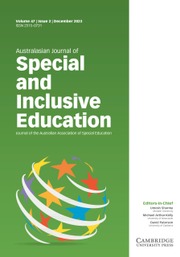Article contents
Communication That Leads to Successful Social Inclusion For Children With Hearing Loss: Are Excellent Speech and Language Skills Sufficient?
Published online by Cambridge University Press: 09 July 2021
Abstract
Many children with hearing loss have atypical social communication skills despite having age-appropriate speech and language. Graduate assessments in an early intervention program for children with hearing loss indicated that despite achieving language skills within typical limits for over a decade, social skills development was frequently delayed. Data gathered in 2007 and 2012 indicated the majority of children with hearing loss demonstrated poor acquisition of concepts linked to theory of mind (ToM), achieving either delayed or alternative acquisition patterns. A small-group 8-week social skills intervention program was subsequently implemented for graduating cohorts with the aim of developing and improving social interactions. In 2017, measures of ToM were collected for 15 children with hearing loss aged 4–6 years and compared to ToM 2007 and 2012 cohort data. An additional measure of social understanding and flexibility, a persuasion task, was also implemented. Although ToM skills for the majority of the 2017 cohort were found to be on par with hearing peers, and were better than skills demonstrated by the 2007 and 2012 graduates, ability to successfully participate in a socially significant persuasion task with a peer was delayed. Challenges and solutions to the development of age-appropriate social skills are proposed.
- Type
- Original Articles
- Information
- Australasian Journal of Special and Inclusive Education , Volume 45 , Issue 2 , December 2021 , pp. 108 - 121
- Copyright
- © The Author(s), 2021. Published by Cambridge University Press
Footnotes
This manuscript was accepted under the Editorship of Michael Arthur-Kelly.
References
- 1
- Cited by


